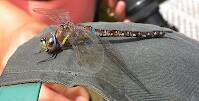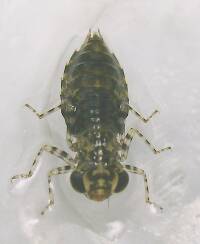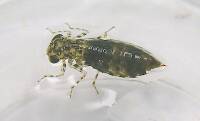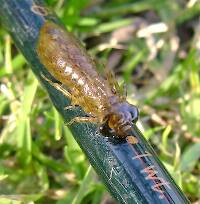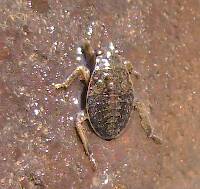
Salmonflies
Pteronarcys californica
The giant Salmonflies of the Western mountains are legendary for their proclivity to elicit consistent dry-fly action and ferocious strikes.
Featured on the forum

Nymphs of this species were fairly common in late-winter kick net samples from the upper Yakima River. Although I could not find a key to species of Zapada nymphs, a revision of the Nemouridae family by Baumann (1975) includes the following helpful sentence: "2 cervical gills on each side of midline, 1 arising inside and 1 outside of lateral cervical sclerites, usually single and elongate, sometimes constricted but with 3 or 4 branches arising beyond gill base in Zapada cinctipes." This specimen clearly has the branches and is within the range of that species.

Troutnut is a project started in 2003 by salmonid ecologist Jason "Troutnut" Neuswanger to help anglers and
fly tyers unabashedly embrace the entomological side of the sport. Learn more about Troutnut or
support the project for an enhanced experience here.
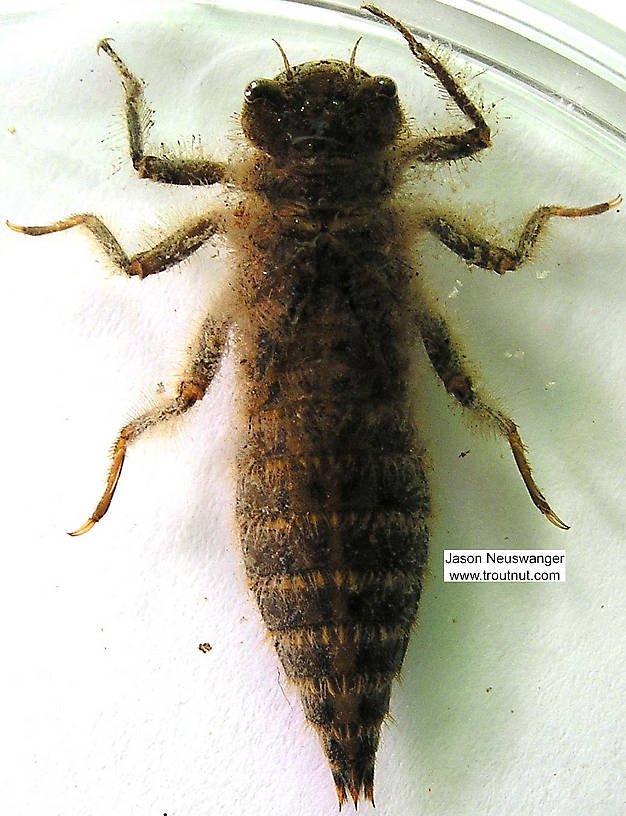
This is a realy big, dark dragonfly nymph. Notice how "fuzzy" it is--it's covered with small hairs that collect sediment and debris and camouflage the nymph to match its natural surroundings. The greenish cast in some of the photos of this specimen is due to strange lighting during my first night photographing things for this site.
IanB
Posts: 3
Posts: 3
IanB on May 4, 2009May 4th, 2009, 8:36 am EDT
I have screened through the images on this site, and I am just having a big trouble identifying this bug I have pulled of a stone in my local river.
It is very large, maybe size 10 or slightly larger, I have found other size 14 bugs of the same shape/style (also in the picture but difficult to see) and when I came across this monster I had to know what I had found. Also, after finding very similar nymphs that are size 14, can this one actually be a dragonfly? Is it just a monster of the 'normal' brown drake? Or hendrickson hatch I have heard about on this stream?
The real issue, is that I don't see a 'normal' set of twin tails, or three tails. (again not the technical term) what I do see (on the smaller and larger bug) is almost like a large paddle, and it uses this vertical paddle to swim in the water. The head is extremely flat, and it has two small antenna (like the dragonfly photo's) and two very small barbed jaw-like protrusions below the antenna and below the eye's where the mouth would be. The back appears to have two sets of wings, (neither have fully emerged) and the eye's are very similar to the dragonfly eye's in the photo's here. Also there is almost no color at all to the fly, it is a very dark mud brown/black. It looks about the same color as all the flies I pull out of the river (except the neon green caddis). Not sure if that is just a characteristic of the river, or the bug (the color that is)
One thing that is not the same, is the abdomen (bulbous in shape in the photo's on this site) does not appear to be the same as the example I have. The bug I have has a tapered abdomen going back to this 'paddle' I mentioned earlier.
More 'macro' photo's tonight when I get home, these are crappy cell phone pics for now.
Thank you for any help!
IB

https://stillmaninteriors.sslpowered.com/Images/bug.jpg
It is very large, maybe size 10 or slightly larger, I have found other size 14 bugs of the same shape/style (also in the picture but difficult to see) and when I came across this monster I had to know what I had found. Also, after finding very similar nymphs that are size 14, can this one actually be a dragonfly? Is it just a monster of the 'normal' brown drake? Or hendrickson hatch I have heard about on this stream?
The real issue, is that I don't see a 'normal' set of twin tails, or three tails. (again not the technical term) what I do see (on the smaller and larger bug) is almost like a large paddle, and it uses this vertical paddle to swim in the water. The head is extremely flat, and it has two small antenna (like the dragonfly photo's) and two very small barbed jaw-like protrusions below the antenna and below the eye's where the mouth would be. The back appears to have two sets of wings, (neither have fully emerged) and the eye's are very similar to the dragonfly eye's in the photo's here. Also there is almost no color at all to the fly, it is a very dark mud brown/black. It looks about the same color as all the flies I pull out of the river (except the neon green caddis). Not sure if that is just a characteristic of the river, or the bug (the color that is)
One thing that is not the same, is the abdomen (bulbous in shape in the photo's on this site) does not appear to be the same as the example I have. The bug I have has a tapered abdomen going back to this 'paddle' I mentioned earlier.
More 'macro' photo's tonight when I get home, these are crappy cell phone pics for now.
Thank you for any help!
IB

https://stillmaninteriors.sslpowered.com/Images/bug.jpg
Taxon on May 4, 2009May 4th, 2009, 9:29 am EDT
Ian-
Your photo is sufficient to determine the specimen is not a dragonfly nymph, as the abdomen outline is not right for a dragonfly, nor does a dragonfly have tail-like gills. Rather, it is a damselfly nymph (with a rather stout abdomen) of family Coenagrionidae, probably of genus Argia.
Your photo is sufficient to determine the specimen is not a dragonfly nymph, as the abdomen outline is not right for a dragonfly, nor does a dragonfly have tail-like gills. Rather, it is a damselfly nymph (with a rather stout abdomen) of family Coenagrionidae, probably of genus Argia.
IanB
Posts: 3
Posts: 3
IanB on May 5, 2009May 5th, 2009, 2:40 am EDT
Wow, I am so surprised you are able to identify it with such a poor picture!
In anycase as promised here is a better picture (although I must say it is a bit worse for wear after a day in a plastic container). But hopefully this will confirm the damselfly nymph theory posted below.
https://stillmaninteriors.sslpowered.com/Images/DSCN2178.JPG
https://stillmaninteriors.sslpowered.com/Images/DSCN2179.JPG
https://stillmaninteriors.sslpowered.com/Images/DSCN2180.JPG
In anycase as promised here is a better picture (although I must say it is a bit worse for wear after a day in a plastic container). But hopefully this will confirm the damselfly nymph theory posted below.
https://stillmaninteriors.sslpowered.com/Images/DSCN2178.JPG
https://stillmaninteriors.sslpowered.com/Images/DSCN2179.JPG
https://stillmaninteriors.sslpowered.com/Images/DSCN2180.JPG
Creno on Feb 8, 2017February 8th, 2017, 8:18 am EST
This popped up in the trail with Mill Creek's damselflies. Clearly this is a dragonfly not Argia. These trails are great as they allow us to correct errors over time.
Taxon on Feb 8, 2017February 8th, 2017, 10:24 am EST
Hi Dave-
In the interest of clarification, the paddle-tailed damselfly nymph, which I believed to be of family Coenagrionidae, probably of genus Argia nearly eight years ago, was not the dragonfly nymph which appears at the top of this thread. But rather, the photo was located at https://stillmaninteriors.sslpowered.com/Images/bug.jpg, but seemingly no longer is. :-)
In the interest of clarification, the paddle-tailed damselfly nymph, which I believed to be of family Coenagrionidae, probably of genus Argia nearly eight years ago, was not the dragonfly nymph which appears at the top of this thread. But rather, the photo was located at https://stillmaninteriors.sslpowered.com/Images/bug.jpg, but seemingly no longer is. :-)
Creno on Feb 10, 2017February 10th, 2017, 4:48 am EST
Okee Dokee then - sorry for not paying attention :-) When did you move to TX? you can PM if you want.
Taxon on Feb 10, 2017February 10th, 2017, 8:49 am EST
Hi Dave-
No problem. My wife (to whom I had been married for over 51 years) passed away in May of 2016. So in August of 2016, I moved to TX to live with my son and his family.
Best regards,
No problem. My wife (to whom I had been married for over 51 years) passed away in May of 2016. So in August of 2016, I moved to TX to live with my son and his family.
Best regards,
Quick Reply
Related Discussions
Topic
Replies
Last Reply
Re: Help obtaining photos of larval insects for a City of Denton, TX photographic key to ID'ing.
In the Identify This! Board by Rdjudy
In the Identify This! Board by Rdjudy
1
Jul 28, 2008
by Taxon
by Taxon
0
Dec 7, 2006
by Troutnut
by Troutnut
6
Mar 27, 2011
by Doublea176
by Doublea176



